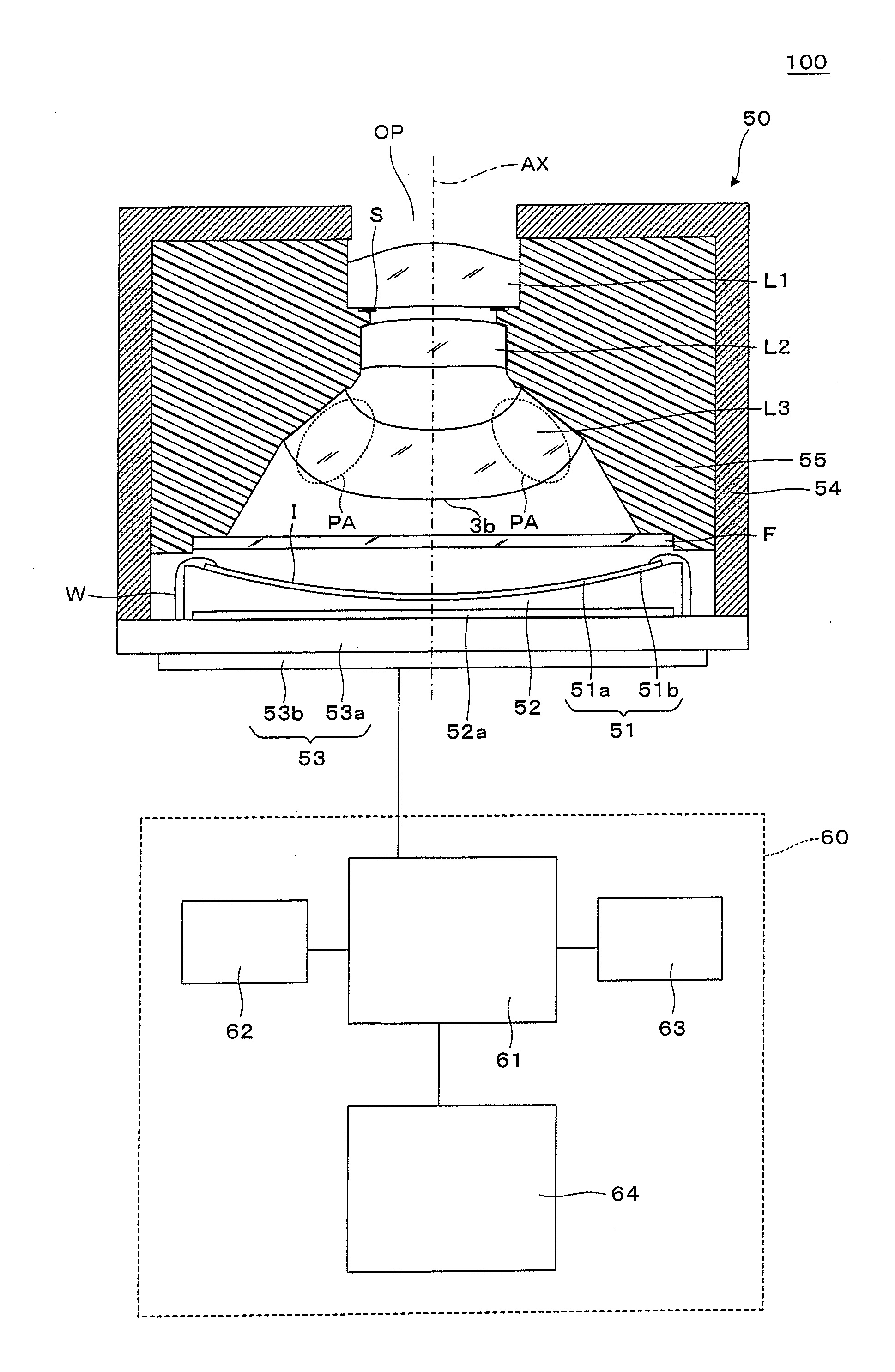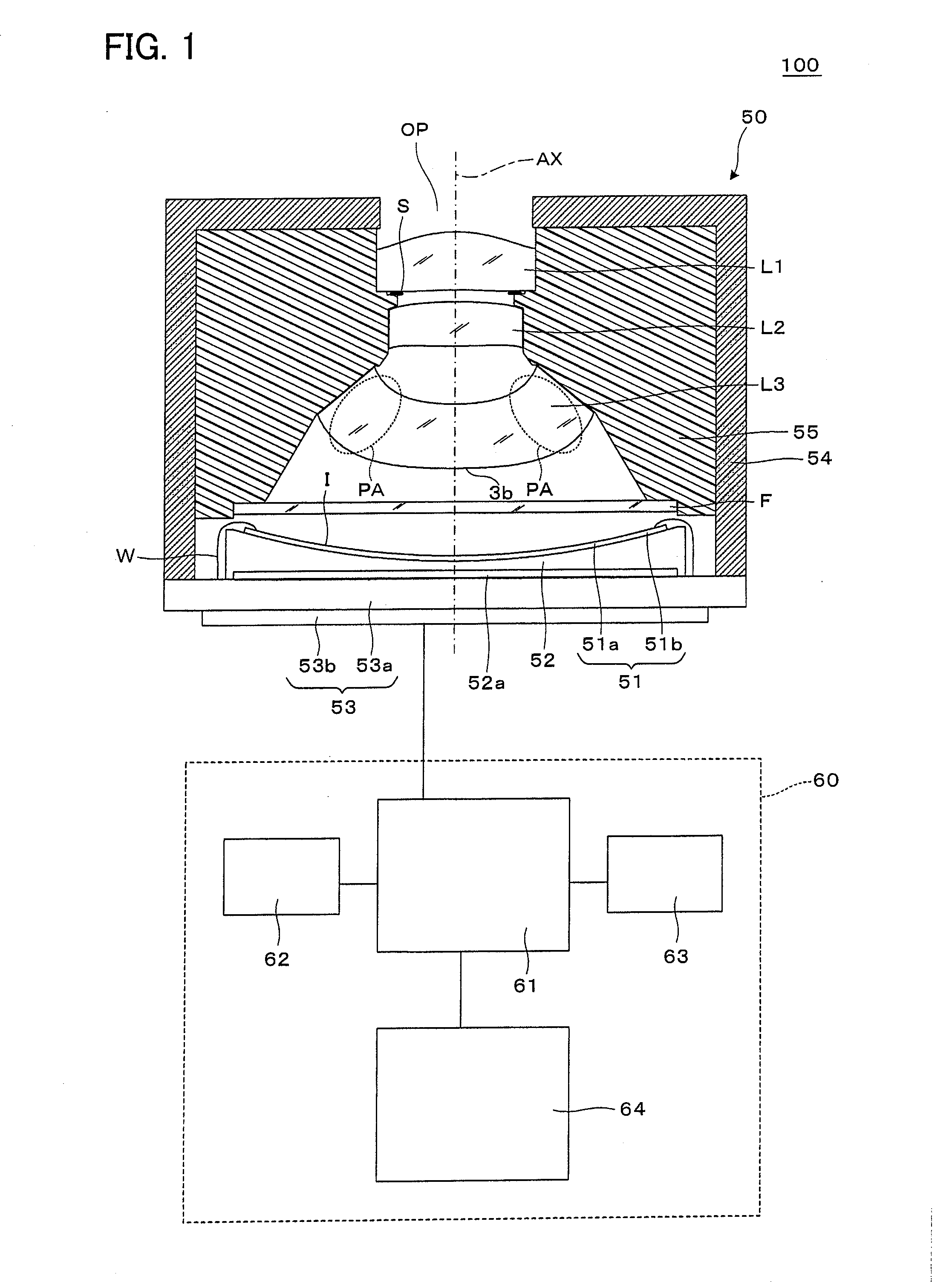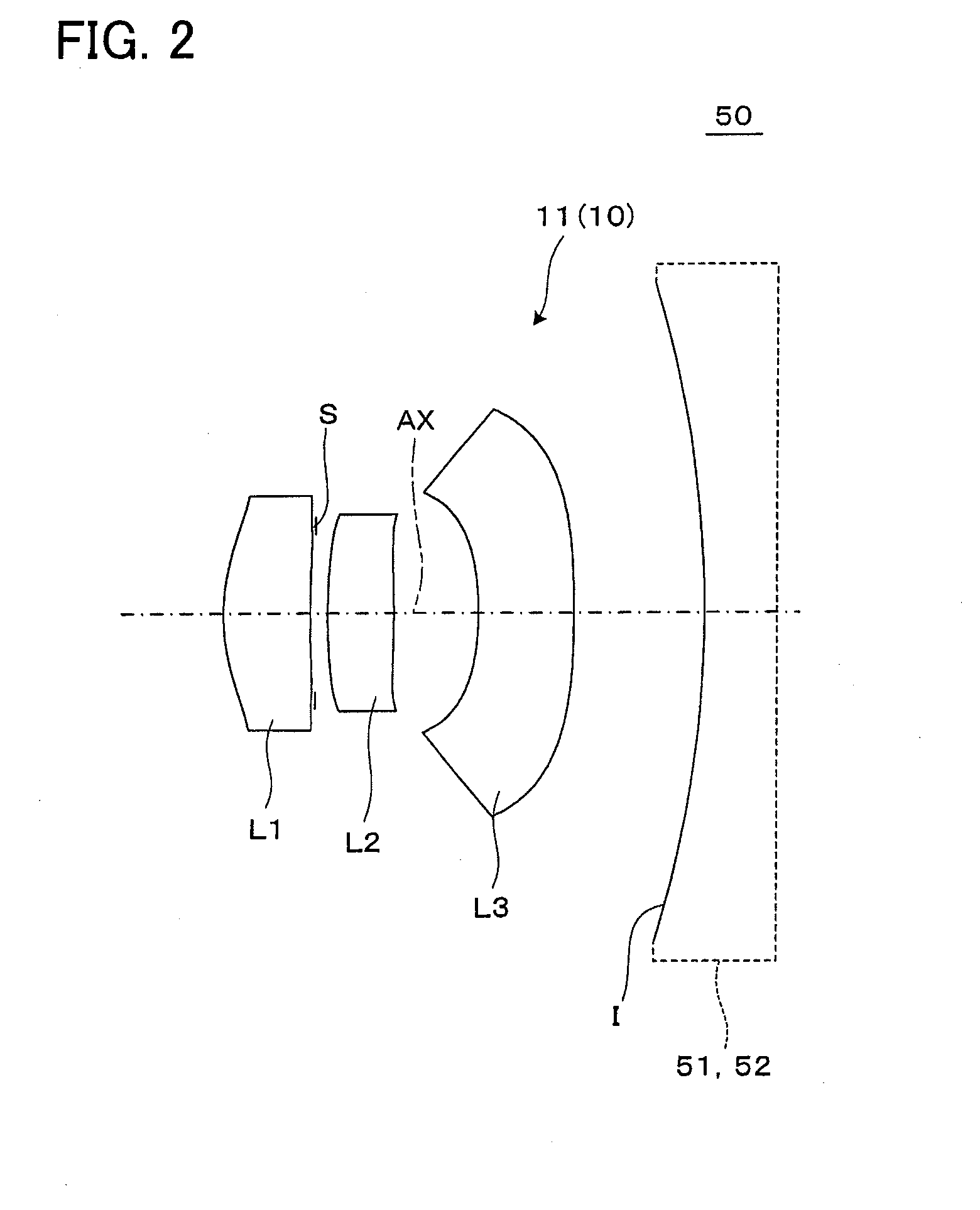Image Pickup Lens And Image Pickup Device
a pickup device and image technology, applied in the field of compact image pickup lenses, can solve the problems of insufficient correction of chromatic aberration, inability to expect to obtain an image pickup device of high performance, and difficulty in achieving a sufficient reduction in the size of the image pickup lens and the image pickup device, and achieve excellent formability and suppress shading
- Summary
- Abstract
- Description
- Claims
- Application Information
AI Technical Summary
Benefits of technology
Problems solved by technology
Method used
Image
Examples
example 1
[0111]General specifications of an image pickup lens of Example 1 are as follows.
f=2.38 mm
fB=0.76 mm
F=2.4
2Y=3.5 mm
ENTP=0.41 mm
EXTP=−1.07 mm
H1=−0.31 mm
H2=−1.63 mm
[0112]Lens surface data of Example 1 is shown in Table 1 below. “STOP” means the aperture stop S and “IMAG” means the image pickup surface I.
TABLE 1SurfaceEffectivenumberR (mm)D (mm)Ndvdradius (mm)1*1.1610.491.5447056.20.662*4.2220.030.473 infinity0.070.45(STOP)4*3.7880.371.5447056.20.485*−6.6890.480.556*−1.9100.541.6347023.90.687*−5.9780.741.158 −6.354(IMAG)Aspherical surface coefficients of the lens surfaces of Example1 are as follows.First surfaceK = −0.25843E+01,A4 = 0.45319E−01,A6 = −0.20599E+00,A8 = −0.68537E+00,A10 = 0.55464E+00Second surfaceK = −0.30000E+02,A4 = −0.21862E+00,A6 = −0.77470E+00,A8 = 0.21693E+01,A10 = −0.14820E+01Fourth surfaceK = 0.15140E+02,A4 = 0.32865E−01,A6 = −0.31885E+00,A8 = 0.40411E+01,A10 = −0.38145E+01Fifth surfaceK = −0.30000E+02,A4 = 0.11738E+00,A6 = 0.87909E+00,A8 = −0.25596E+01,A10 = 0.946...
example 2
[0116]General specifications of an image pickup lens of Example 2 are as follows.
f=2.39 mm
fB=0.6 mm
F=2.4
2Y=3.5 mm
ENTP=0.44 mm
EXTP=−1.26 mm
H1=−0.23 mm
H2=−1.78 mm
[0117]Lens surface data of Example 2 is shown in Table 3 below.
TABLE 3SurfaceEffectivenumberR (mm)D (mm)Ndvdradius (mm)1*1.1910.481.5447056.20.682*2.3150.050.463 infinity0.070.44(STOP)4*2.0150.451.5447056.20.505*−5.0960.380.606*−2.0100.901.6347023.90.657*−9.5700.601.328 −6.969(IMAG)Aspherical surface coefficients of the lens surfaces of Example2 are as follow.First surfaceK = −0.23484E+01,A4 = 0.62251E−01,A6 = −0.11697E+00,A8 =−0.39497E+00,A10 = 0.19543E+00Second surfaceK = −0.41745E+01,A4 = −0.11680E+00,A6 = −0.65316E+00,A8 = 0.91685E+00,A10 = −0.75003E+00Fourth surfaceK = 0.45036E+01,A4 = −0.67987E−01,A6 = −0.42921E+00,A8 = 0.97000E+00,A10 = −0.76215E+00Fifth surfaceK = −0.30000E+02,A4 = −0.93881E−01,A6 = 0.38334E+00,A8 = −0.22038E+01,A10 = 0.35467E+01Sixth surfaceK = −0.39257E+01,A4 = −0.55727E+00,A6 = 0.50788E+00,A8 = −0....
example 3
[0121]General specifications of an image pickup lens of Example 3 are as follows.
f=3 mm
fB=1.73 mm
F=2.8
2Y=4.536 mm
ENTP=0 mm
EXTP=−1.71 mm
H1=0.38 mm
H2=−1.27 mm
[0122]Lens surface data of Example 3 is shown in Table 5 below.
TABLE 5SurfaceEffectivenumberR (mm)D (mm)Ndvdradius (mm)1 infinity−0.060.53STOP2*1.2180.651.5447056.20.563*2.1070.600.654*−801.6790.611.5447056.21.035*−3.2481.721.336 −6.893(IMAG)Aspherical surface coefficients of the lens surfaces of Example3 are as follow.Second surface K = −0.83589E−01, A4 = 0.63341E−02,A6 = 0.17877E+00, A8 = −0.62056E+00, A10 = 0.16155E+01, A12 = −0.18854E+01 Third surface K = 0.43853E+01, A4 = 0.72575E−01, A6 = −0.65234E−02, A8 = −0.10661E+00, A10 = 0.80743E+00, A12 = −0.73994E+00 Fourth surface K = −0.94483E+05, A4 = 0.30860E−01, A6 = −0.10667E+00, A8 = 0.14926E+00,A10 = −0.23616E+00, A12 = 0.18440E+00, A14 = −0.66932E−01 Fifth surface K = −0.34691E+02,A4 = −0.44080E−01, A6 = 0.55225E−01, A8 = −0.22438E−01, A10 = −0.25165E−01, A12 = 0.21006E−01,...
PUM
 Login to View More
Login to View More Abstract
Description
Claims
Application Information
 Login to View More
Login to View More - R&D
- Intellectual Property
- Life Sciences
- Materials
- Tech Scout
- Unparalleled Data Quality
- Higher Quality Content
- 60% Fewer Hallucinations
Browse by: Latest US Patents, China's latest patents, Technical Efficacy Thesaurus, Application Domain, Technology Topic, Popular Technical Reports.
© 2025 PatSnap. All rights reserved.Legal|Privacy policy|Modern Slavery Act Transparency Statement|Sitemap|About US| Contact US: help@patsnap.com



